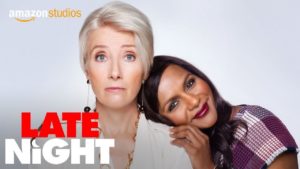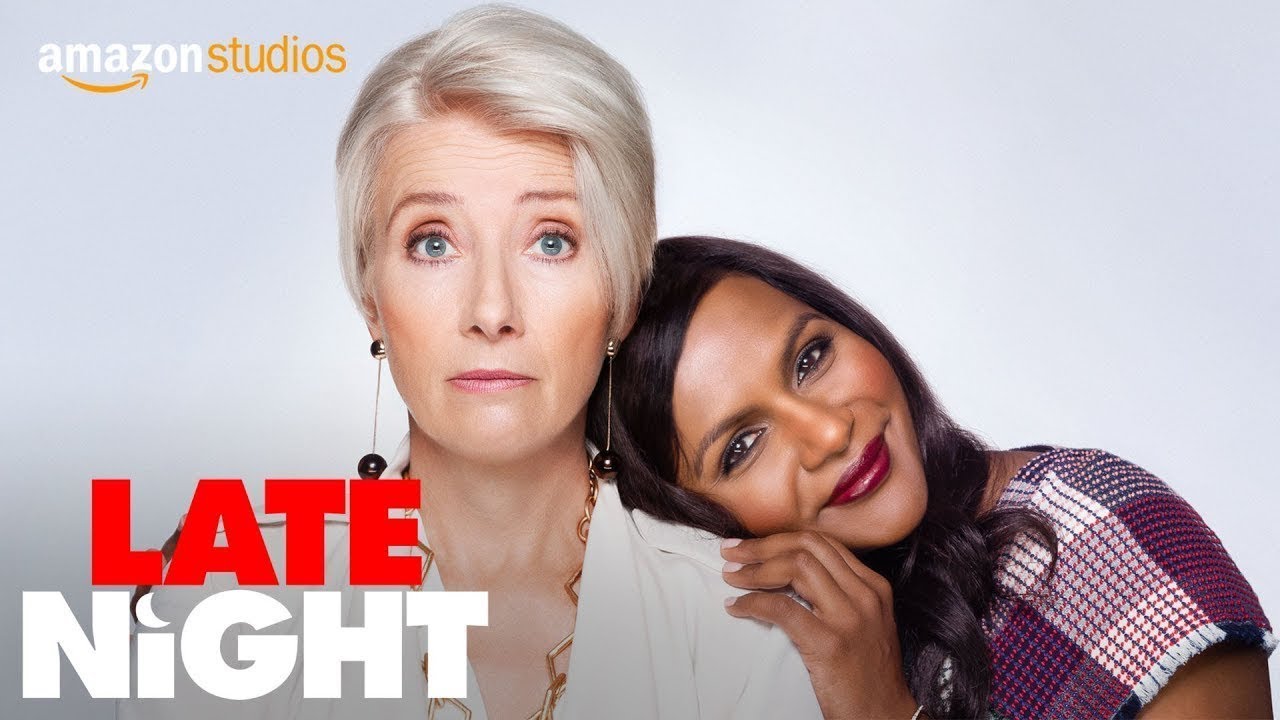Late Night
Posted on June 6, 2019 at 5:01 pm
B +| Lowest Recommended Age: | High School |
| MPAA Rating: | Rated R for language throughout and some sexual references |
| Profanity: | Very strong language |
| Alcohol/ Drugs: | Smoking, social drinking |
| Violence/ Scariness: | Reference to deaths of parent and co-worker, tense confrontations |
| Diversity Issues: | A theme of the movie |
| Date Released to Theaters: | June 7, 2019 |

Kaling plays Molly, a quality control specialist in a chemical plant who gets a one in a million shot at the job by winning an essay competition. Katherine (Thompson) has just imperiously ordered her long-suffering producer (Denis O’Hare) to add a woman to the all-male, all-white writing staff, so he gives Molly a chance. What the writers do not know is that the new head of the network (Amy Ryan), who likes to talk about “four-quadrant” audiences (males and females over and under 25 years old) and ROI (return on investment), thinks Katherine, despite her multiple Emmys and other awards, has become out of date and out of touch with her audience. Ratings are down, and Katherine is unlikely to boost them as long as she insists on having guests like Senator Diane Feinstein and historian Doris Kearns Goodwin.
Katherine demands “excellence” from everyone around her, and that means total dedication. Her manner is abrupt and imperious and she fires staff like she’s the Queen of Hearts calling “Off with their heads!” She refuses to capitulate to what she considers the dumbing down of the media (and the world). When her producer persuades her to have a viral YouTube star who makes videos of her sniffing her dog’s butt on the show, the withering contempt she cannot hide alienates her shrinking audience further. She is pushed onto social media, but her first joke about Twitter bombs, perhaps because she calls it “Twittah” but also because she has not taken the time to understand what it is.
There are just two things she cares about, her husband (John Lithgow), who is in the early stages of Parkinson’s Disease, and her show. Both are being taken from her, and she does not have the resources to respond.
Katherine literally does not know the names of her writers, many of whom have never even met her. She has no interest in learning their names, and when she finally sits down in the writers’ room, she assigns them all numbers.
Kaling, who was both writer and actress on the US version of “The Office,” has a good feeling for the “He Man Women Haters”-Our Gang-style dynamics of the all-male writer’s room. They are so used to having no women around that they use the ladies’ room. And her being there doesn’t stop them. At first, she brings her quality control perspective, analyzing what’s missing from the show, until one of the writers gives her some good advice: write something.
Kaling has said that (until “Wrinkle in Time”) every part she has had is one she has had to create for herself. Her strength as a writer is giving us characters who are three-dimensional, vivid, and smart. Both Molly and Katherine filter Kaling’s experiences and perspective in writing for television, the relentlessness of sifting through jokes to put together a polished monologue of perfectly crafted comedy only to have to start over again the next day, the treacherous balancing act between giving enough of yourself to connect with the audience while keeping enough private to keep your sanity and sustain relationships, the even more treacherous challenge of staying on top while people who are every bit as ambitious try to topple you.
She shortchanges Molly a bit here, particularly when she lets herself get hurt by someone her character would be instantly wary of. We get the sense that it is the Katherine character who interests her more, and it gives Thompson one of her all-time best roles. In the first half, she effortlessly tosses off Katherine’s most devastating take-downs, a woman who insists on excellence in a world that does not seem to want it. But in the second half, when Katherine has to be unsure and vulnerable, Thompson gives a performance of exquisite depth and precision. “I hope I have earned the privilege of your time,” Katherine tells her audience. Kaling and Thompson make the privilege ours.
Parents should know that this film includes substantial strong language, sexual references, some potty humor, smoking, and infidelity.
Family discussion: Would you have hired Molly? Why didn’t Katherine change sooner? What was Katherine’s funniest joke?
If you like this, try: “Dancing in September” and “The Mindy Project” and “Larry Sanders Show” television series

